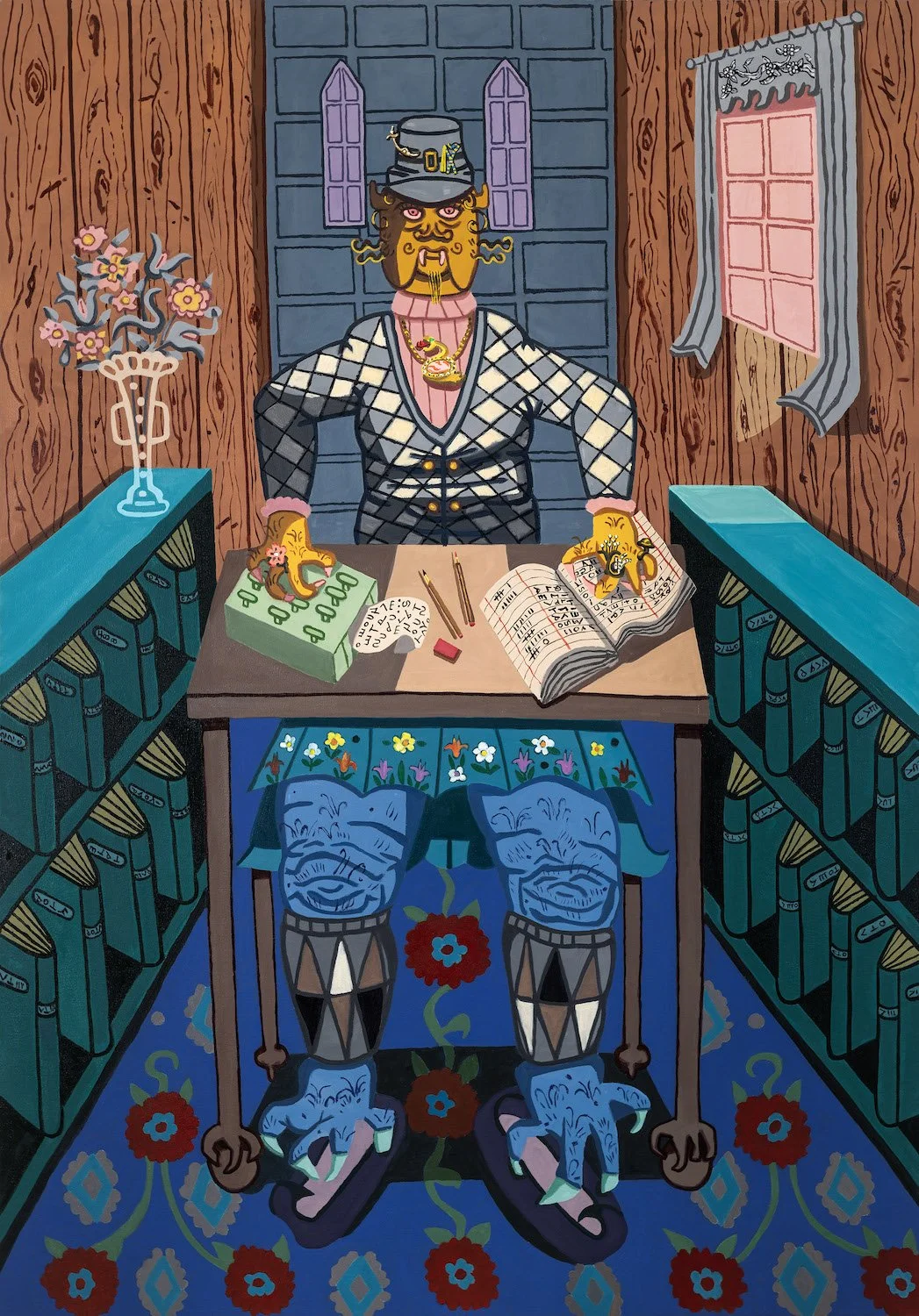Elastic Tricksters: Hannah Barrett’s Machine Elves
Hannah Barrett, The Sibyl, 2024, oil on canvas, 60 x 42 inches
Transplanted into interiors of epistemic authority and overrunning sites of containment with protean elasticity, Hannah Barrett’s hybrid creatures embody both psychic and material liminality, performing the delicate work of chronicling and dissemination that underlies both personal and cultural becoming. As the seraphic intermediaries who originally made contact with Hildegard Von Bingen, Barrett’s alchemical tricksters are resurrected queer homunculi, plucked from the margins of Medieval illuminated manuscripts. Reanimated in Victorian polychrome, Barrett’s queer custodians thrive. Cloistered in very gay Akashic libraries, they flourish as fierce Mahakala gatekeepers performing the duties of dandy record keepers. As above, so below, except for the anatomy of The Sibyl, in Barrett’s paintings, androgynes faithfully transmit rune light code from somewhere over the rainbow.
Both sprites and elves exist as animating forces safeguarding thresholds. In folklore, sprites inhabit the in-between; they protect and destabilize, mediating the edge between order and wildness. The etymology of sprite is the Latin word spiritus, meaning breath or spirit. In esoteric circles, spirit animates matter through endogenous dimethyltryptamine secreted from the pineal gland. Also known as the spirit molecule, DMT plays a role in REM sleep, near-death experiences, and certain mystical states. Entities encountered on DMT are described by the ethnobotanist Terence McKenna as “self-transforming machine elves.” These fractal, ever-morphing, playful psychopomps bestow gifts of knowledge to seekers who traverse the unknown.
Tapping into the roles and structure of myth-making in fairy tales, Barrett’s characters function similarly as archetypal mediators dissolving binaries. Male and female, grotesque and refined, wild and domesticated exist simultaneously, coupling the best of all worlds. Humor and unbounded mutant joy level the absurdity of taxonomy and ridicule the sanctity of category. Resistance is futile! A gnarly snapping turtle thumb has already plunged deeply into every alpine pie. Nestled in every tidy corner, the boundaries of the antiseptic chambers of the rational mind have been breached. The kaleidoscopic hills are alive! A cyclops, with labial folded knees that have already seen too much, is on the loose. Barrett’s charming canvases declare, querdo is here to stay.
In Barrett’s paintings, we enter a laboratory of paradox. Libraries and administrative chambers, spaces historically reserved for the safe keeping of knowledge, become timecapsules preserving sacred queer history. Here, Barrett’s polymorphously perverse librarians, detectives, and scholars channel and record. It turns out, indeed, you can learn a lot of things from the flowers, including dandy-speak, as evidenced in the notation of a lederhosen-clad researcher roaming a bucolic field in Montanvert. Methodical, systematized, and in a fastidious fashion, Barrett’s critters unworld regulation and co-create for oddkins. Floral familiars, fruit bowls, mushrooms, and snail helpers, symbols of queer identity, reverberate throughout like microcosmic Russian nesting dolls, mirroring gender nonconformity as both intrinsic and foundational to the structure of reality.
In Barrett’s saturated paintings, both color and language disrupt hegemony and inherited knowledge systems. Color becomes a queer strategy, a crucible forging resistance, a subversive, chromophilic onslaught challenging normative austerity. Enacting chromatic rebellion, Barrett’s psychedelic hermitages violate sterile logic, embedding affective warmth in spaces where classification reigns. Queer code punctuates Barrett’s paintings, reinscribing ideas around legibility, passing, and secrecy. Relax, we are all friends of Dorothy. Both ancient and futuristic, their mystical language is logged in ledgers, transcribed from notebooks, typed on mycelial computing devices, and printed out on scrolls. Contained in mysterious volumes, their script speaks to the various methods that queer stories find their way into history, the boon of discovering one’s difference, the joy of belonging to a tribe of deep freaks, and the labor of creating agency for future generations. At the heart of Barrett’s lusus naturae oeuvre is the refusal to be erased on a bureaucratic level.
Text by Wells Chandler
Exhibition essay for Hannah Barrett’s exhibition at The Schoolhouse Gallery, Provincetown, MA, July 21- August 9, 2025
